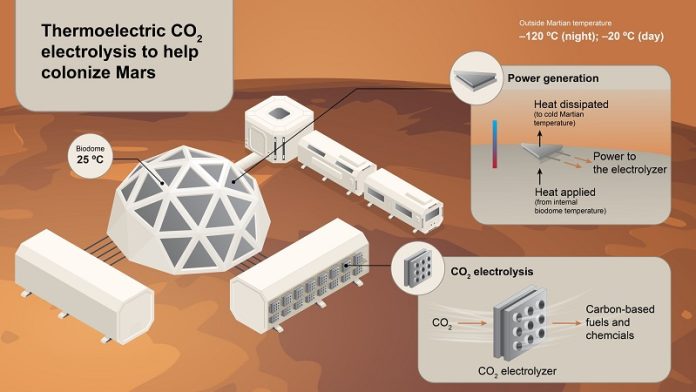
Imagine using temperature differences to turn carbon dioxide (CO₂) into useful chemicals and fuels.
This idea has inspired researchers at the University of British Columbia (UBC), who have shown that simple thermoelectric generators could power this transformation in many environments, including Earth and Mars.
Thermoelectric generators (TEGs) create electricity by sitting between two surfaces with different temperatures.
In the lab, scientists connected TEGs to a hot plate on one side and an ice bath on the other.
They found that when the temperature difference was at least 40°C, these off-the-shelf TEGs generated enough current to power a device called an electrolyzer, which converts CO₂ into carbon monoxide (CO).
CO can then be used to make various chemicals and fuels, which could be very useful in future applications.
Dr. Abhishek Soni, the lead author of the study, sees potential for this technology beyond Earth, especially on Mars. The Martian atmosphere is 95% CO₂, and surface temperatures vary widely, from 20°C during the day to -153°C at night.
This extreme temperature difference would allow TEGs to generate electricity by capturing the heat inside a biodome on Mars and transferring it through the generator into the cold, outside air.
This electricity could then power the conversion of Mars’ CO₂ into materials and fuels that a Martian colony would need.
The possibilities are equally exciting here on Earth. TEGs could be installed at geothermal sites, where hot pipes run from underground to the cooler surface.
The temperature difference between the pipes and the surface could generate electricity, which could then power CO₂ conversion devices. These devices could transform CO₂ from geothermal plants or other industrial sources into useful chemicals and fuels, helping reduce greenhouse gases.
Professor Curtis P. Berlinguette, the principal investigator of the study, highlights that this technology could make “carbon-neutral” fuels and materials.
For instance, using TEGs and electrolyzers could help create plastic for future uses—whether on Earth or Mars—without adding more CO₂ to the atmosphere.
Next, the researchers want to test how these TEGs perform with their CO₂ converters outside the lab, in real-world settings. If this technology works as expected, it could open doors to more sustainable ways of creating fuels and materials, possibly supporting human life on Mars one day.
With both scientific and environmental benefits, this research offers a glimpse into a future where waste CO₂ is transformed into something valuable, using nothing more than temperature differences.



